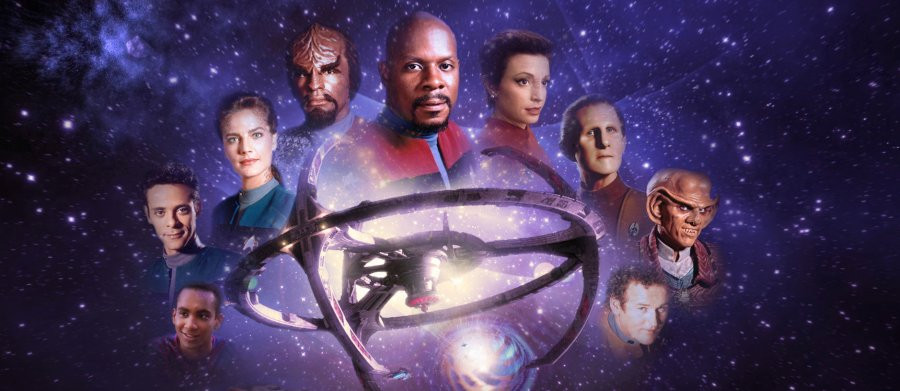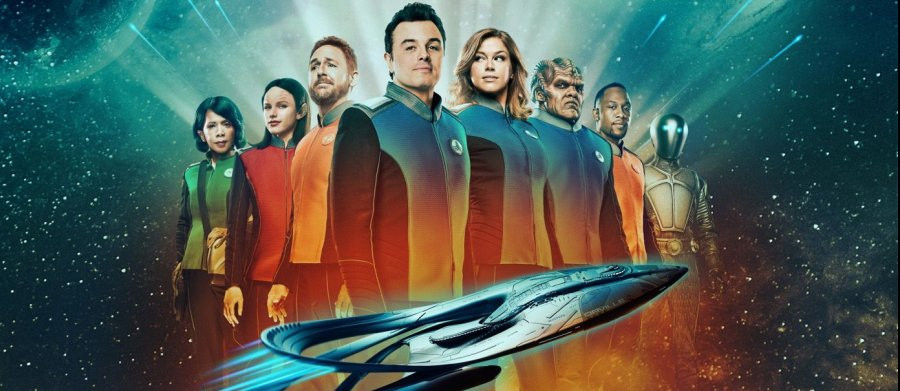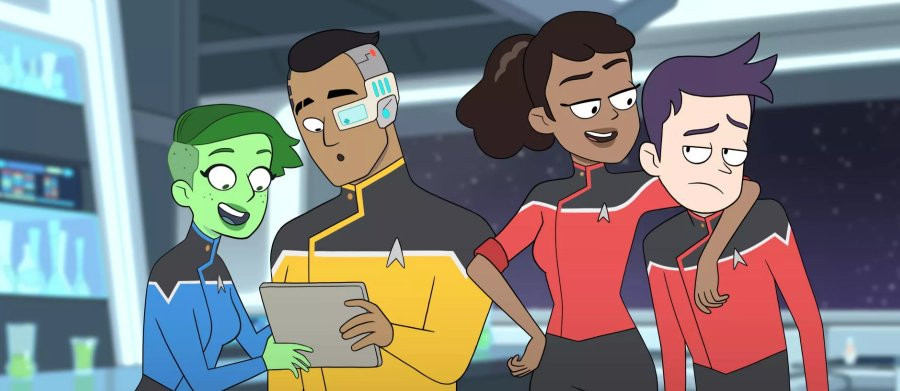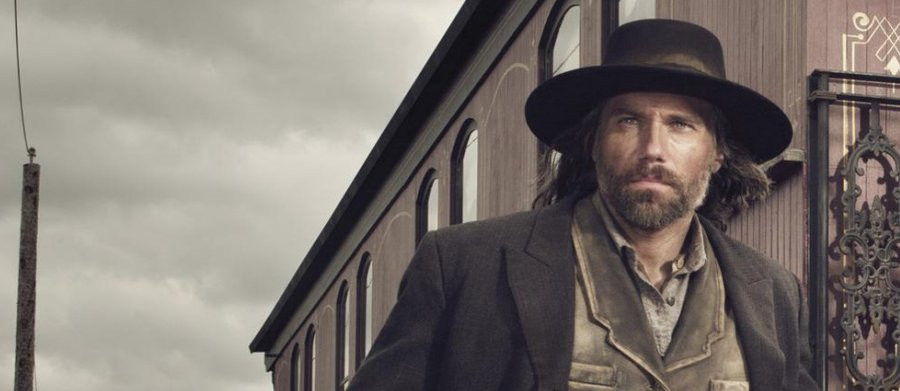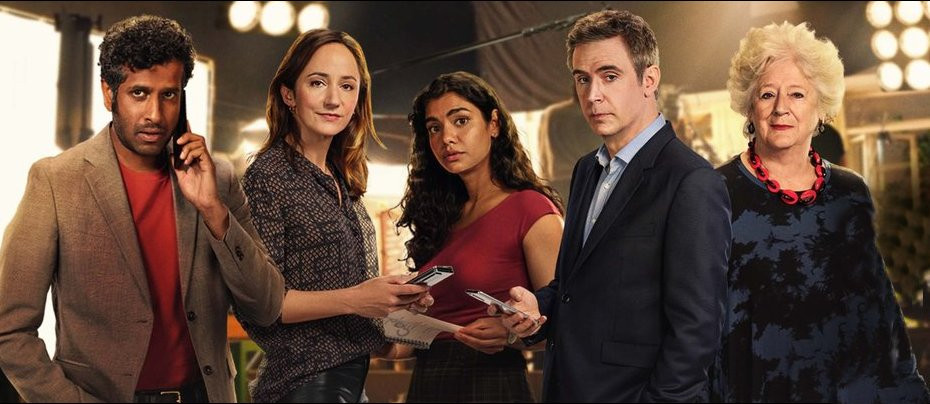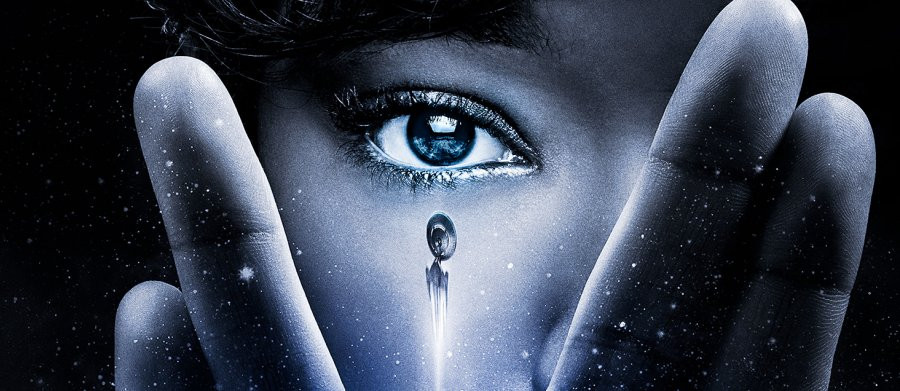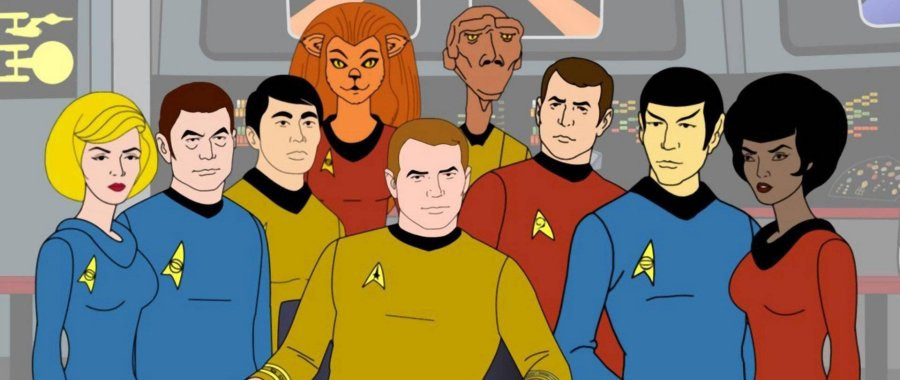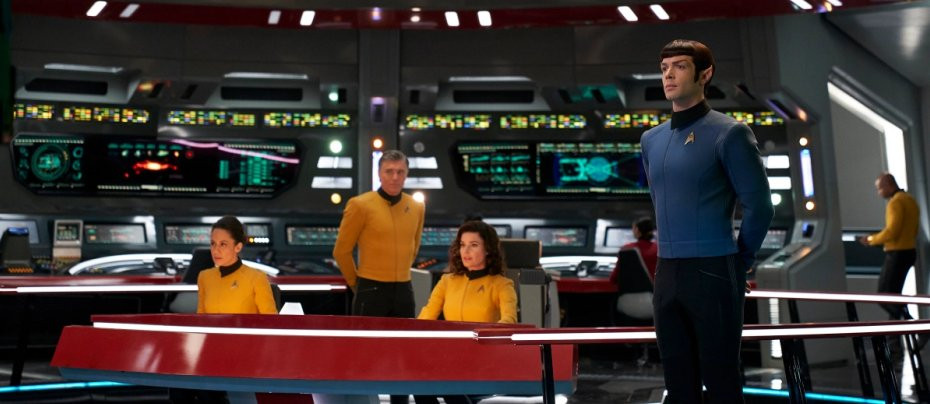
Star Trek: Strange New Worlds
2022 - United States“Its flaws accepted, Strange New Worlds has as solid a first season as any iteration of Star Trek has ever managed”
Seasons 1 & 2 review by Daniel Tessier
The eighth live action series in the Star Trek franchise, Strange New Worlds has its roots in both the modern reimagining's of Trek and its deep past. Showing us the adventures of Captain Christopher Pike and the USS Enterprise crew, Strange New Worlds takes place several years before the original Star Trek and the voyages of Captain James T. Kirk.
Back in 1964, filming for the Original Series began with the pilot episode, “The Cage,” starring Jeffrey Hunter as Captain Pike; Majel Barrett as his first officer, known only as Number One; and Leonard Nimoy as the young alien science officer, Mr. Spock. NBC, who had bankrolled the production, rejected “The Cage,” citing several reasons, including a claim that its story was “too cerebral,” and feedback from a test audience, who didn't like the cold and bossy woman as second-in-command. (Some claims from the production team in later years suggest it was Barrett in particular the studio and audience disliked, rather than the notion of a female first officer.)
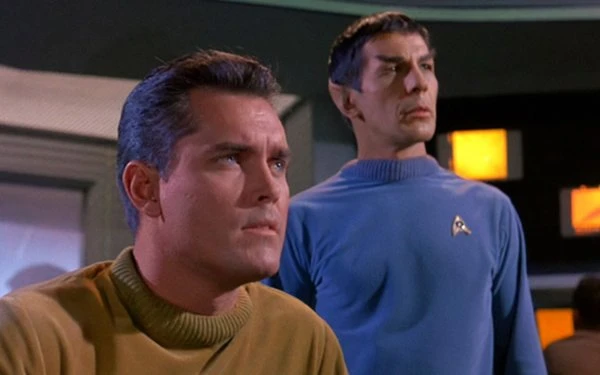
Unusually for the time, and likely trying to recoup some costs, NBC gave Desilu Studios the go-ahead to film a second pilot with a number of changes requested. This became “Where No Man Has Gone Before,” introducing Captain Kirk and broadcast as one of Star Trek's earliest episodes. Footage from “The Cage” was recycled for flashbacks in the two-part story “The Menagerie,” which positioned Pike as the captain of the Enterprise before Kirk. “The Cage” wasn't broadcast intact until 1988.
Fast-forward to 2019, and the second season of Star Trek: Discovery. Set after “The Cage” but before the Original Series proper, this season saw Captain Pike, now played by Anson Mount (Hell of Wheels, Inhumans) take temporary command of the USS Discovery, while Number One, now played by Rebecca Romijn (Ugly Betty, X-Men) looking after the Enterprise for him. Pike goes on a search for Spock, now played by Ethan Peck (10 Things I Hate About You, Penny Dreadful: City of Angels), who is on his own mysterious mission.

This wasn't the first time Pike and Spock had been recast for the modern age (that had been Bruce Greenwood and Zachary Quinto for the 2009 film Star Trek), but both Mount and Peck received critical acclaim and positive audience reception. It wasn't long before fans were asking CBS to give the new Pike and Spock their own series. Covid-19 naturally slowed things down, but it was only a few years before Strange New Worlds became the latest show in this new age of Star Trek.
The first series set on an Enterprise since, well, Enterprise, Strange New Worlds is decisively more episodic than the largely serialised Star Trek: Discovery and Star Trek: Picard. It's a deliberate move back to a more old-fashioned, pre-streaming style of television. That said, there are elements that run through the season, so individual episodes are not entirely stand-alone. Like Discovery and Picard, Strange New Worlds sees a shorter season than Trek fans were used to, with only ten episodes.
Mount's Captain Pike develops from the version we met on Discovery. He is both more troubled and more easy-going. While Jeffrey Hunter portrayed Pike as a resolute, angry and extremely serious man, and Bruce Greenwood played him as authoritative but good-humoured and open-minded, Mount's Pike is an extremely likeable, often light-hearted, father-like figure to his crew. While he can certainly pull rank and call on his authority when he needs to, he has a far more relaxed attitude with his bridge crew than any captain we've seen in the franchise (and most the ones we had before weren’t exactly sticklers for military protocol). Pike is not only a commanding officer but provides his crew with well-chosen words of emotional support and wisdom, and even cooks for them. He's the very image of positive masculinity.
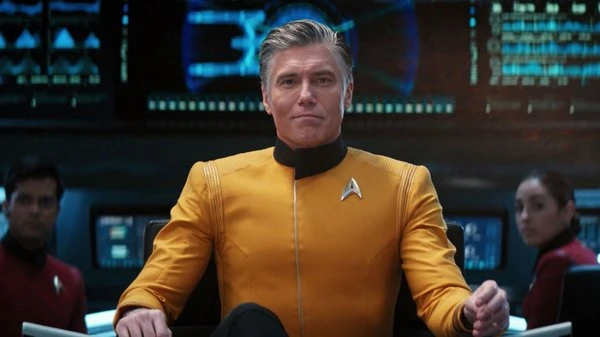
However, there's a darker undertone to this, and Pike is weighed down by knowledge of his own future. “The Menagerie” introduced Pike as a man left helplessly disabled by severe radiation poisoning, fallout from his rescue of several young cadets on a ship whose engine had gone critical. In the Discovery episode “Through the Valley of Shadows” Pike was given a terrifying glimpse of his destiny, not enough to shake him from mission at the time but enough to lead him to stay on Earth the next time the Enterprise returned there. It's here that we find him at the beginning of Strange New Worlds, where he is finally persuaded to return to the command chair by Admiral Robert April, played by British-Canadian actor Adrian Holmes (Bel-Air, True Justice). While Pike throws himself back into command, his fate still weighs heavily upon him.
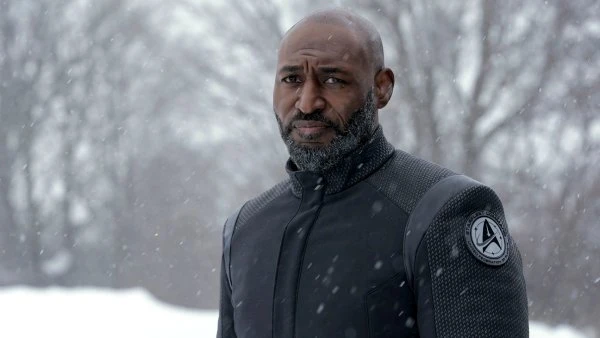
April, the first captain of the Enterprise and Pike's mentor, takes his name from Gene Roddenberry's very first treatment for Star Trek. He made his way into Trek lore as Pike's predecessor, only appearing onscreen once before, in the final episode of Star Trek: The Animated Series, “The Counter-Clock Incident.” This portrayed him as a rather generic old white man, voiced by James Doohan (who, as well as Scotty, voiced pretty much every male incidental character in the Animated Series). Later, he appeared in various Star Trek novels in much the same vein, albeit as an Englishman. Casting Holmes, an actor of colour, as the first live-action version of April drew some inevitable backlash from the more close-minded and reactionary fans. They may claim it's a problem since it contradicts what went before but given that the Animated Series is only arguably Star Trek canon there's no reason not to cast whoever they like in the role, and Holmes brings the gravitas to the part that the first captain needs.
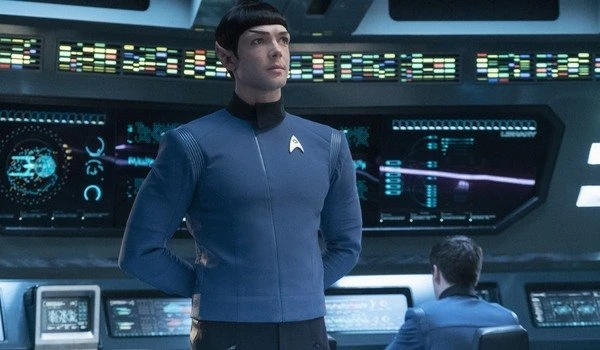
Strange New Worlds recasts many characters familiar from the Original Series – some more recognisably than others. Ethan Peck studied Nimoy's performance as Spock, recreating much of it but also putting his own unique spin on the role as a younger Spock, still struggling to deal with the clash between his emotions and his logic. It's a tough gig, having to portray an allegedly emotionless character but retaining enough of a distinct personality to make him different to all the other Vulcans in the series. This includes T'Pring, Spock's betrothed. Originally played by Arlene Martel in the Original Series episode “Amok Time,” T'Pring is now portrayed by Gia Sandhu (The Mysterious Benedict Society, A Simple Favour), who does an amazing job of making T'Pring somehow even more reserved than Spock yet simultaneously extremely sassy. Sandhu appears in six of the season's ten episodes.
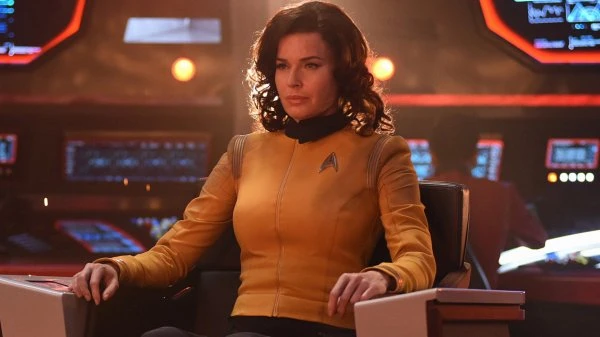
Number One is, after decades, finally given a full name on screen: Commander Una Chinn-Riley. This is drawn from Star Trek novels, as are her origins on the planet Illyria, although this is spun into a new backstory for the character. The Illyrians are revealed to be a genetically engineered race, and as such illegal in the Federation. Una's secret comes out during the course of the series, and she is reliant on her captain to maintain that secret lest she be arrested. The genetic engineering ban has been part of Trek lore for a long time but is highlighted here for what it really is: a fearful bigotry against a minority group within the supposedly tolerant Federation. In herself, Una is straightlaced and by-the-book, but has clearly has a warmer and more rebellious side, even if the junior crew do call her “Where fun goes to die.” Much like Pike, Number One is a more humanised version of the original character from “The Cage.”
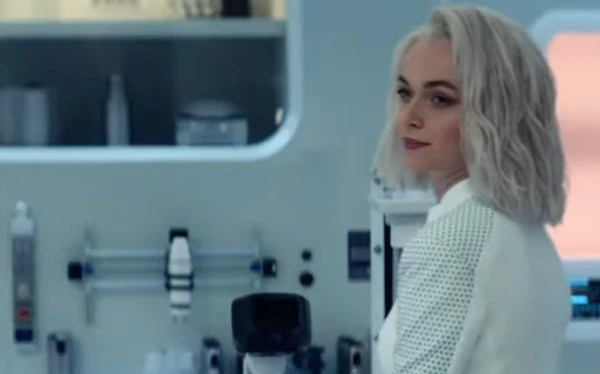
When Number One was passed over as a regular character on the original Star Trek, Majel Barrett was cast in the recurring role of Nurse Christine Chapel. On Strange New Worlds this role is taken by Australian actor and model Jess Bush (Playing for Keeps, Home and Away). Bush's Chapel is virtually unrecognisable as the same character as Barrett's, but this is no bad thing: the original Chapel's fifties-style, repressed career gal who just needs to settle down with the right man wouldn't really fly today. With this in mind, you have to wonder why the showrunners resurrected the character at all, but Chapel's new persona, a flirtatious and quirky charmer, works in its own right. Bush is a delight in all her scenes, although they missed a trick by not having the same actor play both Chapel and Number One and simply never mentioning it.
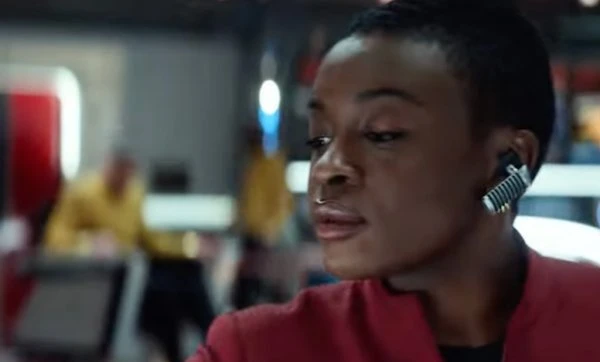
The most well-known of all the characters on the series, after Spock, is Uhura, here a fresh young cadet still figuring out her path in life. After Nichelle Nichols in the Original Series and Zoe Saldana in the reboot movies, Uhura is here played by Celia Rose Gooding, who has previously mostly worked in musical theatre, earing awards for her role in Jagged Little Pill. Gooding gives the young Uhura a believable uncertainty and nervousness but can clearly be seen as an earlier version of the character we knew in the original.
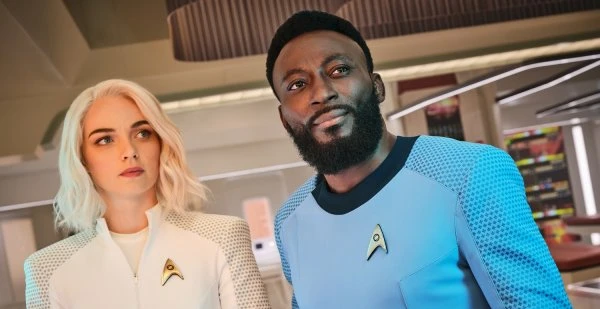
The final regular character taken from the Original Series is Dr. M'Benga, a medical officer who appeared in only two episodes of the original. Here promoted to regular and made the chief medical officer of the Enterprise, he is played by Nigerian-American Babs Olusanmokun (The Defenders, Black Mirror, Roots) taking over from Booker Bradshaw. M'Benga is torn between his duty to the Enterprise crew and the welfare of his daughter (Sage Arrindell), who is dying of a seemingly incurable disease. M'Benga is therefore keeping her illegally suspended in a transporter beam, periodically materialising her to spend time with her and work on treatments. Olusanmokun gives the good doctor a quiet wisdom, but gives a passionate performance when the story requires it.
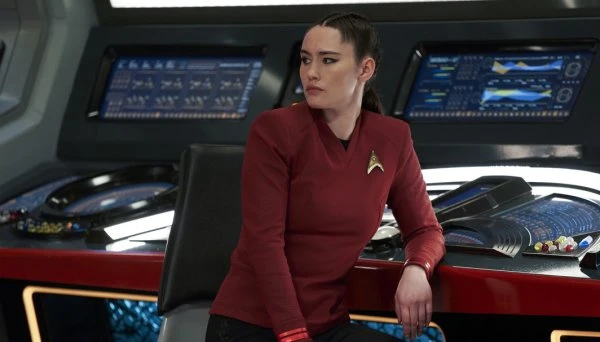
There are plenty of entirely new characters on the crew as well. English actor Christina Chong (Line of Duty, Of Kings and Prophets, Doctor Who) plays La'an Noonien-Singh, the new security chief of the Enterprise. La'an has a suitably horrific backstory, being the only survivor of an attack by the alien Gorn when she was a child. Naturally she's very troubled, keeping herself guarded and reserved but haunted by guilt and terror from her experiences. She has a close friendship with her mentor Una, though, and gradually opens up as the season progresses. La'an is a descendant of the evil dictator Khan Noonien Singh (played originally by Ricardo Montalban on the Original Series and Star Trek II: The Wrath of Khan), who is the very reason genetically engineered people are hated in the Federation. As such she has experienced discrimination all her life, although you have to wonder why she didn't change her name: being called La'an Noonien-Singh is the Trek equivalent of being called Badolf Hitler or Paul Pot.
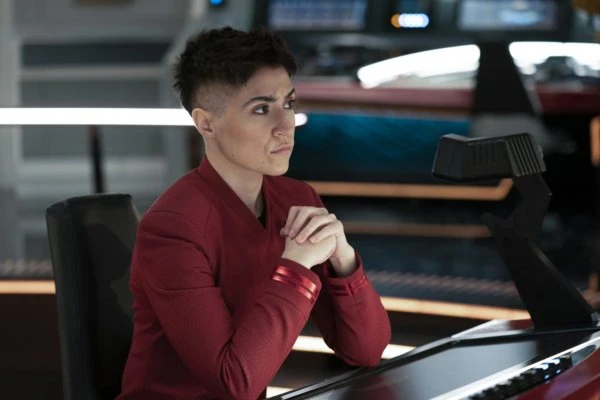
Columbian actor Melissa Navia (Dietland, Billions) plays Erica Ortegas, the Enterprise helm officer. Ortegas remains a bit of a mystery at the end of the first season; likeably jokey and mostly easy to be around, she has displayed a harder side, but there's still a lot we don't know about her. Navia is fun to watch in all her scenes and deserves to get more material in the second season.
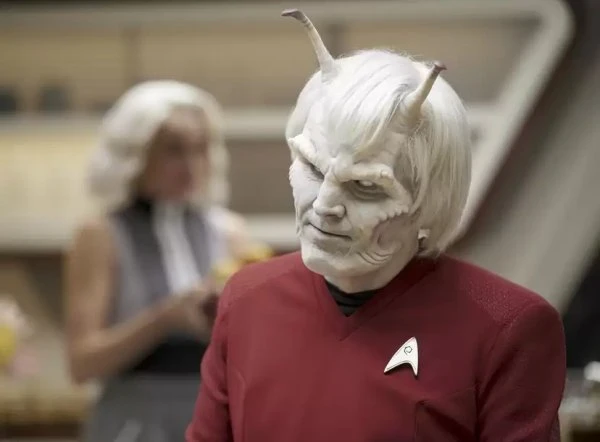
The final regular is Hemmer, the chief engineer and a member of the Aenar people. Originally introduced in the final season of Star Trek: Enterprise, the Aenar are an albino subspecies of the blue-skinned Andorians and are blind and telepathic. He is played by Bruce Horak (In the Dark), who is legally blind, a rare instance of an actor with a disability being cast appropriately in a major role in such a series. Unlike most telepathic characters, who tend to be either flamboyantly open or mysterious and ethereal, Hemmer is a curmudgeonly sort with little patience. He does have a tendency of dropping words of wisdom at opportune moments and forms a mentor-like relationship with Uhura. Horak is also a little underused for much of the season (he doesn't even get a line in the opening episode) but comes into his own in episodes eight and nine.
Occasional recurring characters include Melanie Scrofano (Letterkenny, Winonna Earp) as Captain Batel, Pike's fellow officer/friend-with-benefits, and Dan Jeanotte (Good Witch, Reign) as Lt. Sam Kirk, an officer with a rather more famous brother. Sam only previously appeared dead, for a few seconds in the Original Series, played by William Shatner in a false moustache. With nothing to go on he's given free rein to create a fun character.
While Strange New Worlds harks back to the more episodic format of the classic Trek series, with a relatively brief ten episodes there's less room for variety than those series, and less room for filler. Good thing, then, that the standard of the adventures is high and that the writers and directors have worked on making each episode distinct. This is a highly entertaining series that still has time to make some moral and social points in its storytelling. It's also, like Star Trek: Discovery and Star Trek: Picard, explicitly working for broad representation. While this is something that the original Star Trek also made pains to do, the franchise fell behind somewhat during the second age of TV Trek. Strange New Worlds is continuing modern Trek's approach to inclusion, with people of various ethnicities, sexualities and genders in the cast and characters. There's also been a remarkable amount written about the regular characters' hair, with Navia's buzzcut sides, Gooding's short-cut natural African hair and, especially, Mount's mighty quiff all achieving digital column inches. The latter, which seems to grow taller each episode and has been affectionately nicknamed “Pike's Peak,” has become a minor pop culture phenomenon in itself. So many memes...
SPOILERS AHEAD
The first episode of the series, itself titled “Strange New Worlds,” is a classic slice of Trek. Admiral April convinces Pike to return to the Enterprise to go rescue his Number One, who's missing on a mission to Kiley 279, a planet with a civilisation that have just invented warp power. Normally this is the signal for Starfleet to go make first contact, but the Kiley people haven't invented warp drive, but a warp bomb, which threatens to take the ongoing war between the world's two factions into apocalyptic territory. This would be bad enough, if the aliens hadn't based their new WMD tech on what they observed in Discovery season two's climactic battle. (Presumably they have really good telescopes.)
Classic Trek liked to give officers surgical makeovers so that they could infiltrate enemy ships and pre-contact civilisations. On Strange New Worlds, Chapel injects Pike, Spock and La'an with something to alter their DNA so that they resemble the locals. (This is in spite of that genetic engineering ban.) Naturally, Una and her team are rescued, even though Spock's half-Vulcan DNA messes with the disguise. Pike then decides to beam back and scare the hell out of the planet's government, with a crash course in Earth's 21st century history, from the Second American Civil War, to the Eugenics Wars, to World War Three and the near extinction of humanity. It's a bit of a swizz – there's never any clue given to why the planet's factions are trying to destroy each other, and they're very easily convinced to make nice again – but it works as a very traditional bit of Star Trek.

Episode two, “Children of the Comet,” is an excellent story. The Enterprise is sent to deal with a comet that threatens to collide with an inhabited planet, only to be confronted by a group of extra-terrestrial zealots who worship the comet as a god and are violently opposed to anyone obstructing “His Will.” The away team who have entered the comet discover a huge chamber containing a powerful alien computer – it's a comet, a god, and a spaceship! Young Uhura has lost her way, uncertain as to whether she wants to be in Starfleet, but realises she's in the right business when she successfully communicates with the computer. It's a great script, remembering and introducing vital character points to Uhura, who is gifted not only in linguistics but also singing, the final piece of the puzzle. Gooding gives a great performance, the visuals are astounding and the episode really, ahem, sings.
Episode three, “Ghosts of Illyria,” is the series' big misfire. The Enterprise visits an apparently abandoned Illyrian colony to investigate where the genetically engineered people went. Pike and Spock end up trapped on the surface during an ion storm, while on the ship an undetectable contagion has snuck through the transporters and is turning people into light-craving lunatics. The trapped landing party and mad crew plots are both Star Trek favourites, but this episode offers nothing new with them. It's altogether mediocre, and while the light-craving leads to some dramatic moments where crewmembers almost destroy the ship while trying to overload the engines, there are dreadful scenes in which Una fights off the infection by getting all sexy and hot and bothered, in the way female characters have had to sex it up pointlessly for decades. There's some good stuff in here about prejudice, but mostly the story falters until the twin revelations of Una's Illyrian heritage and M'Benga's fiddling with the transporter to hide his daughter. It's the closest the series comes to serialisation, and shows it works better with discrete adventures.
Much better is the fourth episode, “Memento Mori,” a taut space thriller. Some of Trek's finest moments have hinged on deep space battles influenced by submarine films. “Memento Mori” gives itself over entirely to this subgenre, with the Enterprise investigating a Federation colony that has been wiped out in an unprovoked attack before engaging the unknown enemy in a drawn-out standoff on the edge of a black hole. It's a tense, gritty episode, with Pike at his most straightforwardly heroic and commanding. The revelation that the attackers are the Gorn brings La'an to the fore, forcing her to face up to her past trauma but also giving her opportunity to use her insights into Gorn tactics and psychology. A simple episode but tremendously effective.

There's a nice change of pace with episode five, “Spock Amok.” An outright comedy episode, this focuses on the relationship between Spock and T'Pring, as well as Spock's growing friendship with Chapel. The episode title calls back to “Amok Time,” the original Star Trek's second season opener, which saw Spock fighting for his betrothed's hand. This is still about eight years away in-universe, but the cracks in their relationship are already showing. To help them understand each other, Spock suggests an intimate “soul sharing” – a mind meld plus – that will let them share each other's innermost thoughts. Can you believe that such a thing might go wrong? The episode turns into a classic bodyswap farce, with T'Pring forced to pretend to be Spock during some delicate negotiations with a strategically important power, and Spock pretending to be T'Pring when she deals with a Vulcan criminal. It's a testament to both actors that they are able to make the characters distinct during the swap. A subplot about Number One and La'an trying out cadets' “Enterprise” bingo is less effective but still works. It's an all-out comedy episode and great fun, with some silly aliens and a reuse of the classic Trek battle music for some extra nostalgia.
Episode six is a bit of an oddity, an old-fashioned slice of sociological science fiction that doesn't quite land. “Lift Us Where Suffering Cannot Reach” sees Pike reunited with an old flame: Minister Alora of the planet Majalis. Played by Lindy Booth (The Librarians, The Famous Jett Jackson), Alora is rescued by Pike when her shuttle is under attack from aliens, just as he rescued her ten years earlier as a lieutenant when her shuttle was caught in the field of a pulsar. If this seems like a set-up, you wouldn't be too far off since everything else about Alora and her planet's situation is dodgy. Ian Ho (The Expanse) appears as the twelve-year-old First Servant, Majalis' most honoured citizen, with Huse Madhavji (Saving Hope) as his father, the Elder Gamal. Both give amazing performances as the truth of the First Servant's role in Majalan society is slowly revealed. It's an interesting episode with a strong moral debate at its centre, but the story is oddly paced, and the script just doesn't seem to quite hit the right notes.

Episode seven, “Serene Squall,” is a fun romp which sees the Enterprise come up against some good old-fashioned space pirates. Jesse James Keitel (2022's Queer as Folk, Big Sky) guest stars as Dr. Aspen, a special guest onboard ship who is so obviously a villain that it's cathartic when they finally reveal themselves to be the pirate Captain Angel. Fortunately, Keitel's an immensely charming presence, absolutely eating up every scene, and delivering some impactful words to Spock about identity. As well as giving Pike some fun scenes as he cooks his way into the pirates' confidence, starting a mutiny to affect his escape, there's some excellent material between Spock, Chapel and T'Pring. Spock and Chapel had some unresolved feelings for one another in the Original Series, and this episode sees the first direct hints that their relationship grew beyond mere friendship. A solid, entertaining adventure that ends with the reveal of yet another, more surprising villain.
“The Elysian Kingdom” is the setting of our eighth instalment. Dr. M'Benga is still searching for a cure for his daughter Rukiya and reading her stories before bedtime including the eponymous The Elysian Kingdom. A routine scan of an uncharted nebula (they're always bad news) transforms the ship into the Kingdom itself, with the crew's personalities being replaced by those of the fictional characters from the story. Pike becomes a cowardly vizier, Ortegas a warrior, La'an a cheery princess. Only M'Benga himself and, thanks to his psychic abilities, Hemmer remains unaffected, although the others believe them to be the king of Elysia and a Merlin-like wizard respectively. There are some great Hemmer moments as he bluffs his way through it, and Peck is especially good as Spock-turned-evil-warlock. While it's a silly episode, it packs an emotional punch in its closing act as M'Benga is forced to make some difficult decisions about the fate of his daughter.
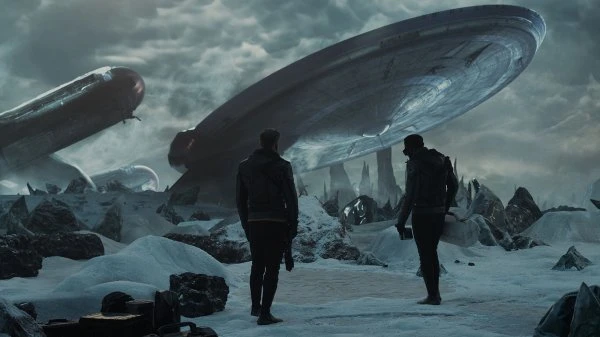
The ninth and penultimate episode, “All Those Who Wander,” is a serious slice of horror, as Pike takes a team down in a shuttle to investigate a sister ship that has crashed on a desolate planet. It isn't long before the landing party discover survivors who the crew had picked up before – a traumatised young girl (Emma Ho, twin sister of Ian Ho and fellow cast member of The Expanse) and a fabulous blue alien called Buckley (Carlos Albornoz) who looks like he's on holiday from Farscape. In short order the episode turns into an Alien rip-off (with elements of The Thing and Predator thrown in for good measure) as hatchling Gorn begin bursting out of bodies and start hunting the survivors through the downed ship.
The Gorn first appeared in the 1967 episode “Arena,” where a lone Gorn faced Kirk in combat. In those days the Gorn was realised by putting a man in a rubber lizard suit. Today, the Gorn are depicted with a mix of CGI and sophisticated puppetry, allowing them to move faster and act far more threateningly. These vicious Gornlings are a far cry from the creature we once met, though, and I kind of miss the rubber suit. While “All Those Who Wander” is incredibly derivative, it's also extremely effective, with some powerful performances, particularly by Chong and Horak as La'an and Hemmer. It's not often Star Trek goes down the horror route, and when it does it's rarely gory, and this is an unforgettable episode with a gut punch of an ending.
Finally, we have “A Quality of Mercy,” which goes all out in its tribute to the original Star Trek. Pike encounters Commander Hansen (Ali Hassan – Designated Survivor) of Earth Outpost 4, and his son – who will grow up to be one of the cadets in the catastrophe in Pike's future, one he fails to save. Pike decides he will warn the boy and the other cadets of the potential accident, saving those he will not be able to otherwise and himself. Immediately a much older Pike appears from the future (decked out in the fancy crimson uniform of the eighties Trek movies) to warn him not to. Our Pike is thrown forward in time seven years, where he has not been injured in the accident and is still in command of the Enterprise. From then on, Pike faces a Romulan incursion at the Neutral Zone, culminating in the destruction of Earth Outpost 4 and its neighbours.
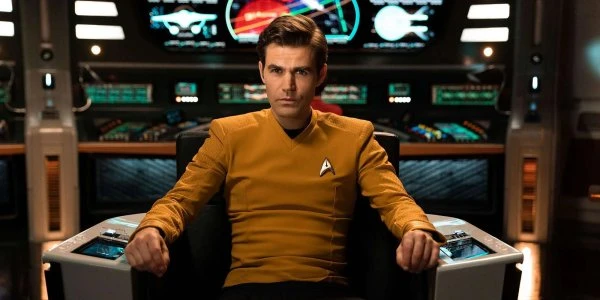
However, it should be one James T. Kirk who is in command, because we've seen this episode before. It's “The Balance of Terror” from 1966, which saw Kirk face down a weary Romulan commander and narrowly avoid an open conflict between the Federation and the Star Empire. The new timeline, with Pike in charge, goes differently, primarily because Pike is less hot-headed than Kirk and tries harder to find a peaceful solution. In spite of some scenes being directly lifted from the original episode (with Strange New Worlds characters sometimes swapped in for the originals), vital events run differently, leading to all-out war between the interstellar nations. Captain Kirk even shows up to help, commanding the USS Farragut. He's played now by Paul Wesley (The Vampire Diaries, Tell Me a Story) who, I'm disappointed to say, simply isn't terribly good in the role. While other characters from the Original Series were changed quite considerably for Strange New Worlds, Kirk is iconic, and getting him wrong is a huge problem for the episode. Although we can take into account that he's playing the more reserved Kirk of the earlier Star Trek episodes, Wesley simply lacks the charisma and swagger of William Shatner or Chris Pine. The casting is crucial to the episode, and Wesley is set to reappear in the second season, so it's a major sticking point.
The episode as a whole works, thanks to some excellent work from Mount, Peck and Bush, who sell the traumatic experiences of the Enterprise crew well. Pike is thrown back to his present, convinced not to change his future, but while it's reaffirming of his heroism that he will sacrifice his happiness to ensure the Federation remains safe, the overall message – that he's simply not as important to the future as Kirk and Spock – is a pretty one to lay on the leading man.
Over ten episodes with plenty of variety, there's definitely more that works than doesn't in this series, with only episode three really falling below the bar overall. At its best, this is Star Trek firing on all cylinders, while other episodes are more qualified successes. The cast aren't immune to danger, and there are some surprising deaths in the course of the run, but with Pike, Spock, Uhura, Chapel, M'Benga and Sam Kirk all on the ship, there are six crewmembers who we know can't possibly die (at least for good). This robs the series of a lot of its jeopardy – we know Spock won't be lost in action, because we've seen his older self in three seasons of the Original Series, two of the Animated Series, eight films and a couple of episodes of The Next Generation. There's also a sense that the series is too nervous to fully engage with its social conscience; when compared to the hard-hitting allegories of the Original Series, The Next Generation, or pseudo-Trek series The Orville, it's a little half-hearted.
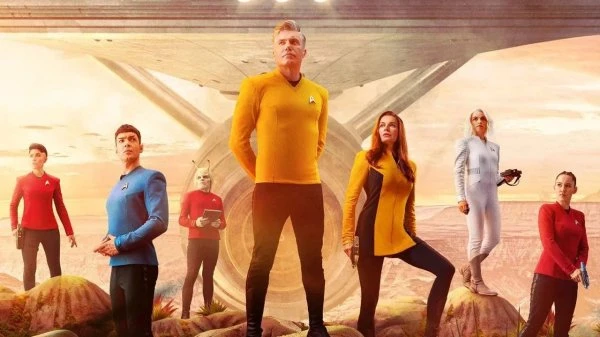
Its flaws accepted, though, Strange New Worlds has as solid a first season as any iteration of Star Trek has ever managed. There's plenty of potential for it to continue delivering memorable adventures until its finally catches up with the show that started it all. With a second season already in the bag, including, surprisingly enough, a crossover with animated comedy series Star Trek: Lower Decks, there's plenty to look forward to from the crew of the Starship Enterprise.
The second season edges us further towards Star Trek: The Original Series
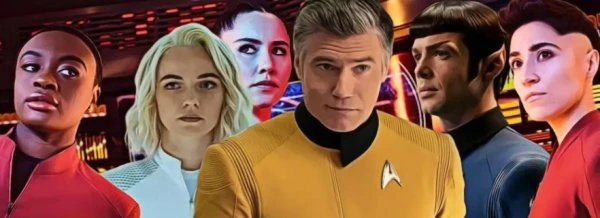
The first season of Strange New Worlds, at present the newest iteration of the Star Trek franchise (albeit not for long) was a major success, the most immediately popular and inarguably effective version of Trek for years. While it's not without its controversies, largely due to its nature as a prequel series that plays fast and loose with established characters and continuity, there's little argument that this is simply a fun and impactful adventure series set in one of science fiction's most beloved universes.
The second season edges us further towards Star Trek: The Original Series, bringing in more recognisable characters and hinting at future events. The writers have a healthy attitude to the franchise's decades-old canon, leaning into the elements they want and happily contradicting things when the story demands it. There are certainly some areas that are hard to square with what we saw in the Original Series, but this is a very different time, and Strange New Worlds works as an updated take on the concept.
Again the season gives us ten episodes, and while this still feels short compared to the classic days of syndicated Trek, the quality is more consistently high. There's also a remarkable variety in style and genre, which makes the season feel bigger and busier than it is. While such an approach means that not everyone will enjoy every episode, particularly the more experimental ones, and there's a certain feeling of emotional whiplash when watching them together, you won't get bored.
The series picks up some months after the first run's cliffhanger ending, with Number One (Rebecca Romijn) arrested for having lied about her origins in order to enter Starfleet, and Captain Pike (Anson Mount) off recruiting her defence council. Under the command of Lt. Spock (Ethan Peck), the Enterprise is in dock undergoing repairs and upgrades, supervised by new Chief Engineer, the mysterious and eccentric Pelia. Played by the wonderful Carol Kane (Unbreakable Kimmy Schmidt, Scrooged), Pelia is a member of an incredibly long-lived alien race, who had lived on Earth hiding her true nature for centuries. It's unclear just how old Pelia is, but her longevity has led to a desperate desire to avoid boredom, and a truly unique personality (not to mention an equally unique accent). A character with secrets going back many hundreds of years, who keeps a stash of valuable antiques as insurance in case the Federation's “socio-economic paradise turns out to be a fad,” Pelia is an absolute joy to watch.
She's all too happy to help Spock disobey the orders of Admiral April (Adrian Holmes) and steal the ship when they receive a distress call in 2.1, “The Broken Circle.” The signal has been sent by La'an Noonien-Singh (Christina Chong), the Chief of Security who has been off on her own mission between seasons. Having ended up on a frontier planet, La'an has discovered that a cabal of Starfleet officers and Klingon warriors are working together to reignite the war between the two powers. It's surprising that the devastating Klingon War, that took up the bulk of Star Trek: Discovery's first season, is only now getting exploration on Strange New Worlds. It's a taut, effective episode, allowing the rest of the bridge crew to flourish out from under Pike's shadow, and boasts some effective action sequences.
Most impressive are Babs Olusanmokun as Dr. M'Benga and Jess Bush as Nurse Christine Chapel, who are revealed to have been knee-deep in the war while the Enterprise and most of its current crew were exploring deep space. It turns out that the Federation experimented with a super-soldier serum, and while this is maybe an unnecessary Marvel-like addition to the franchise, it hints at some frightening truths about M'Benga and Chapel's actions in the war which will only later be fully explored.
We catch up with Pike and Number One in 2.2, “Ad Astra per Aspera.” One of Star Trek's many Latin titles, this one translates as “To the stars through hardship,” an appropriate motto for the franchise. Una is about to go on trial for lying to Starfleet and hiding her nature as a genetically engineered Illyrian, for such meddling with nature is utterly forbidden by the Federation thanks to the Eugenics Wars on Earth centuries earlier.
Pike recruits the Illyrian lawyer Neera Ketoul, an estranged friend of Una's, to come to Starfleet to defend her. Yetide Badaki (American Gods, This is Us, Sequestered) gives a powerful performance as the strong-minded and unflappable attorney, who fights the prejudices of the Federation as she fights Una's case. It's a great episode, doing what Star Trek does best: using a fictitious social injustice as an allegory for a real one. The Federation's open distrust of the Illyrians is based on outdated prejudice and stands in for any number of real-life prejudices. Una could just as easily be someone who had to hide her sexuality in today's world, or her ethnicity in a time not so long ago.
Romijn gives her best performance in the series as her character is put on the stand, defending not only her subterfuge but also the strength of her character and right to be herself. The addition of Captain Batel (Melanie Scrofano – Wynonna Earp) as the prosecuting officer is a little too much, but it does add another level by having Pike on the opposite side to his lover. Part of what makes the episode work so well is that Batel and most of the court clearly don't agree with the law, but have to uphold it, and while Una and Ketoul eventually claim a victory, by its nature it has to be a small one. Aside from the fact that the genetic enhancement ban is still in place over a century later in Trek (being a thread that runs through much of the franchise, up to the recent animated series Star Trek: Prodigy) it serves to remind us that unjust laws are rarely changed easily or quickly.
La'an, being the descendant of the instigator of the Eugenics Wars, has a particular affinity for Number One's situation and her troubled relationship with her past. This becomes the focus of 2.3, “Tomorrow and Tomorrow and Tomorrow,” a time-travel adventure in classic Trek style, which sees La'an recruited by temporal agents when history is altered, preventing the Federation from forming. La'an finds herself on the United Earth Fleet Ship Enterprise, commanded by Captain James T. Kirk – once again played by Paul Wesley, as in the final episode of season one. While the Enterprise fights a war against the Romulans to protect a devastated Earth, the Romulans themselves are messing around in Earth's past. La'an and Kirk are pulled back to 2022 to find and correct the change.

Rather like fan favourites “Future's End” (of Star Trek: Voyager) and Star Trek IV: The Voyage Home, this episode sees our 23rd century heroes trying to fit in on contemporary Earth while the fate of the future hangs in the balance. Like those episodes, this does have its comedic moments, but it's a far more poignant affair. La'an and Kirk fall for each other, while knowing that if they are successful their meeting will never take place. La'an is also forced to confront her ancestry when she learns that the Federation owes its existence to the wars that made her name so hated. It's also a change to see Toronto as the setting for an episode; any number of genre series are filmed in Canada, but most of them pretend that they're actually in the United States.
Adelaide Kane (Reign, Once Upon a Time) makes for a strong guest star as Sera, a 21st century woman who knows more than she should. Wesley gives a better performance as Kirk this time round, bringing both vulnerability and charm to the role. I like him a lot more, but he's still not Kirk. The episode belongs to Christina Chong, though, who gives a heartbreaking performance as La'an and elevates the episode to being more than just another time travel romp.
2.4, “Among the Lotus Eaters,” goes back to Trek's very beginnings with a visit to Rigel 7, the planet the Enterprise was fleeing from in the original pilot episode, “The Cage.” That mission had been so catastrophic that it almost led Pike to quit Starfleet. Five years later in the fiction and almost sixty years later in reality, we revisit the planet to find that Pike left someone behind. It's an intriguing episode, with the planet bathed in a strange radiation that blocks people's memories, leaving Pike, La'an and M'Benga stuck on the planet with only their most ingrained skills to keep them safe. When the radiation starts to affect the crew on the ship, Spock and Ortega (Melissa Navia) are left to try to fly the ship to safety as their identities drift away. It's an intriguing episode that gives Mount a chance to shine, as we see a harsher, angrier side of Pike than we're used to. It's a reminder of the character who we first introduced to in “The Cage” (and the hatchet-job version “The Menagerie”) and shows that underneath the incredibly likeable and balanced Pike of Strange New Worlds there are still echoes of the more aggressive character he started as.
The series lurches into comedy with 2.5, “Charades,” which sees Chapel and Spock forced to confront their feelings for each other at long last. When their shuttle crashes on a strange moon, they are rescued by an other-dimensional race who repair the shuttle and them along with it. Unfortunately, the aliens are confused by Spock's hybrid DNA and restore him as fully human. To make matters worse, it's just in time for his very important dinner with his fiancée T'Pring (Gia Sandhu) and her dreadful mother.
What results is a very silly story where Spock is forced to undergo a gruelling Vulcan ritual with only his human side to fall back on, all the while trying to keep his emotions under control. Ethan Peck gives a great performance as the humanised Spock, although it's getting harder to recognise this revised version of the character as the same one we watched on the Original Series, even before he's had his Vulcan half removed. Ellora Patnaik (Orphan Black, The Expanse) is great as T'Pril, the cold Vulcan matriarch with little time or respect for humans, while Mia Kirshner (The L Word, 24) returns as Spock's mother Amanda following her debut on Star Trek: Discovery. As silly as the episode is, the part that works best is Chapel's plea to the aliens to restore Spock fully, with an impassioned speech about how she loves all of him – Vulcan half and all. It's a beautiful performance from Jess Bush, who's one of the absolute stars of this season.
2.6, “Lost in Translation,” is a solid sci-fi story that gives Uhura some focus. Celia Rose Gooding gives one of her best performances in the role as the communications specialist, now an ensign, is struggling due to the loss of her mentor and having massively overworked herself. The Enterprise is joined by the USS Farragut on a mission to help complete work on a strategically vital communications station at the edge of a nebula, where Uhura's expertise will be vital. Definitely not the best time for her to start experiencing terrifying hallucinations.
Fortunately, on the Farragut is one Lt. James T. Kirk, with Wesley making his third appearance in the role, but his first not to be part of some alternative timeline. This Kirk gets points for not trying to chat up Uhura at the first opportunity (unlike his movie timeline counterpart) and there's the definite feeling that the writers are trying to repair the future captain's reputation. Jim's brother Sam, played by Dan Jeanotte (Good Witch, Reign) is of vital importance in helping Uhura understand what's going on, but he has his own long-simmering rivalry with his hyper-successful brother to deal with as well. While there's some questionable science in the episode, it works, using the classic sci-fi idea of an intelligence so alien it struggles to communicate with humans. With certain characters failing to see eye-to-eye, and Uhura reasserting her remarkable skills in alien language, communication is the episode's key theme.
The highlight of the season for me is episode 2.7, the much-anticipated crossover with animated series Star Trek: Lower Decks. “Those Old Scientists,” taking its name from Lower Decks' spirited attempt to rationalise its own characters referring to the voyages of the Enterprise as the “TOS Era” (that's “The Original Series” in real world terms) is tremendous fun. Starting in the 24th century with the animated crew of the USS Cerritos investigating a mysterious portal, it's to no one's surprise when ensigns Boimler and Mariner are pulled 120 years back in time to meet the Enterprise's own landing party, who are busy discovering said portal. Jack Quaid (The Boys) and Tawny Newsome (Space Force) get to play their characters in live action for the first time, both starstruck by the legendary crew of the Enterprise. The race is on to get them back through the portal to their own times before they mess something up, be it vital Starfleet history or Spock and Chapel's faltering romance. Unfortunately, a bunch of Orions want the portal for themselves.

First and foremost a comedy, it's also a wonderful love letter to Star Trek in all its forms, with Boimler and Mariner standing in for the fans as they meet their heroes and discover they're not exactly how the history books taught. This in turn gets the Enterprise crew talking about their own heroes – the crew of the oft-overlooked Star Trek: Enterprise. There's a particularly nice moment when it's revealed that Number One – a controversial figure at the “present” time of Strange New Worlds who was nearly dismissed from Starfleet – is the literal poster child for Starfleet who inspired Boimler to join. The only thing missing is a scene where someone from even further in the future turns up, and is starstruck upon meeting the Lower Decks crew.
Next we get that emotional whiplash I was talking about, as this feelgood romp is followed by the devastating 2.8, “Under the Cloak of War.” A companion piece to “The Broken Circle,” this delves even deeper into the emotional fallout of the Klingon War. While M'Benga, Chapel and Ortegas were fighting on the frontlines, the rest of the bridge crew were already on the Enterprise on a deep space exploration mission. This leads to a major divide between those who fought in the war, and those who missed it and can't fully appreciate the trauma that their comrades have gone through.
This leads some considerable tension when a Klingon ambassador is brought aboard the Enterprise to be ferried to an important peace conference. Rah might be ambassador now, but he was previously one of the most notorious and feared generals in the Klingon army, before defecting to the Federation in the middle of the war. Rumoured to have murdered his own crew, he is known as the Butcher of J'Gal – the moon where M'Benga and Chapel were stationed during one of the longest and most brutal battles of the war.
The episode flashes between the present day, and the horrifying conditions on J'Gal some years earlier, where Chapel is newly assigned to help M'Benga in the near-impossible task of treating the endless influx of wounded Starfleet officers. The episode examines the divide between the idealistic explorers that Starfleet officers strive to be, and the soldiers that they often have to be. Robert Wisdom (The Wire, Prison Break) gives a strong performance as Rah, ageing and past his prime, likeable and noble on the surface, but clearly hiding something. There's a notable guest appearance by Clint Howard, Trek's longest-serving actor, who first appeared in “The Corbomite Maneuver” in 1966. It's Bush and Olusanmokun who steal the episode, though, particularly the latter, bearing the weight of what really happened at J'Gal all those years ago. It's a brutal, surprising and intense episode.
Episode 2.9 lurches us back in the opposite direction again, with what will be the highlight of the season for some, and the absolute nadir of Star Trek for others. “Subspace Rhapsody” is the much-anticipated musical episode, a first for Star Trek. It's not actually such a huge departure for the franchise – we've had plenty of musical interludes in the past, and far, far sillier events than a dimensional anomaly turning the universe into a musical reality. Of course, musical instalments of long-running series are nothing new, and the script makes a couple of references to Buffy the Vampire Slayer's “Once More With Feeling,” still the high bar for the format. It's nowhere near that calibre, but it is a lot of fun and uses the same approach of forcing the characters into song so that they address their emotional troubles.
The strongest singers are easily Gooding, known for musicals on Broadway and cast as Uhura at least in part because of her singing ability, and Chong, who released her debut single, “Twin Flames,” during the course of the season. Wesley once again appears on the show, and by now you have to wonder if Pike's getting concerned that Kirk is making excuses to be on his ship. He's got a fine voice, and the tension between Kirk and La'an is resolved to an extent (La'an decides to tell him about his other self before a song makes her do it anyway), and while he was wasn't flirting with Uhura, he definitely was with La'an , in spite of already being spoken for (in a call forward all the way to Star Trek II). It's not a happy conversation, but for now he avoids the wrath of La'an.
Mount and Scrofano hold their own, in a fun number which finally forces Pike and Batel to sort out their own relationship. Jess Bush is the centre of a showstopping dance number where Chapel and Spock explosively, and publicly, address their future together (Chapel being obliged to take a career change for a time to tie in with the Original Series). We already knew that Peck and Romijn could hold a tune (their Short Treks debut involved some ad hoc Gilbert and Sullivan), but it's really Gooding's show, as Uhura's ability to connect with people through music again becomes a vital skill. It gets a bit silly when the dimensional anomaly threatens to destroy the entire Federation, but it's worth it for the involvement of the K-Pop Klingons. (No Klingon opera?)
In amongst the songs, the episode finds time to finally give Captain Batel a first name – it's Marie – and it seems that she and Pike have settled on their places in each other’s lives. So you just know she's in trouble. 2.10, “Hegemony,” starts with the USS Cayuga visiting a colony planet just on the edge of Federation space (cost-effectively designed after a midwestern US town). Batel is on the surface when a vast spaceship attacks. The Gorn have finally launched an all-out assault, claiming the planet and sending Starfleet a map with a great big line drawn through it. Given that the planet is technically just outside Federation space, April orders Pike not to cross the new border. With the Gorn jamming communicators and transporters, it would be virtually impossible to reach the planet and help survivors. Naturally, they do it anyway.
It's a thrilling episode, a nail-biting end to the season that puts the crew through the wringer. There's still the issue that we know most of the regulars are going to be safe, as they have to survive to appear in the Original Series, but it's nonetheless a taut and frightening story. The Gorn attacks remain derivative – a cross between Alien and the raptor sequences of Jurassic Park – but are no less effective for it. Steal from the best, after all. We finally get to see an adult Gorn, realised not as a CGI animation but a performer in a very sophisticated animatronic costume, in a remarkable scene in which Spock and the Gorn, both in spacesuits, fight in the wreckage of the Cayuga. Peck gives his best performance as Spock, having shown both dramatic and comedic skills already this season, as he stops at nothing to save Chapel. Also making an impression is young Scottish actor Martin Quinn (The Lovers) as a legacy character whose identity you can probably guess.
Executive Producer Akiva Goldsman has stated in interviews that the Gorn are outright monsters, something that Pike echoes in his own report to April. This is not a very Star Trek thing to say at all, but already there are hints that there's something more to the Gorn than meets the eye. The episode ends on a gripping cliffhanger, leaving us waiting for season three (greenlit before the second season even started airing). More boldly experimental than the first season, this latest series won't please everyone all the time, but with such variety packed into its brief run, there's something for every taste, be it comedy, romance, adventure, high concept science fiction or outright horror.
Seen this show? How do you rate it?
Seen this show? How do you rate it?
Published on August 15th, 2022. Written by Daniel Tessier for Television Heaven.


